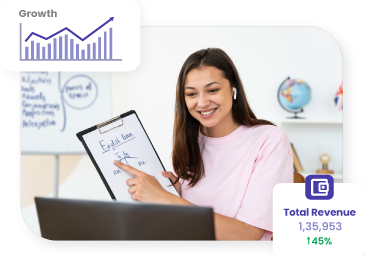The traditional 9-to-5 work model is no longer the only path to success. More individuals are becoming creators, building businesses around their skills. The creator economy, fueled by platforms like YouTube, Instagram, and TikTok, allows professionals to earn directly from their audience.
This shift, however, comes with challenges. Creators face platform dependency, pressure to produce engaging content, and monetization complexities. As more people join these platforms, standing out becomes harder, requiring constant adaptation to changing algorithms and audience demands. Despite these hurdles, the creator economy is redefining work and success in the digital age.
In this blog, we’ll explore the forces driving the rise of the creator economy, the challenges creators face, and its long-term impact on individuals and the global economy.
What is a Creator Economy?
The creator economy is an ecosystem where individuals create content for digital platforms and earn income through various monetization methods. What started as a niche hobby has become a thriving industry, driven by platforms like YouTube, Instagram, TikTok, and Patreon.
Technological advancements, such as video editing tools and AI-powered analytics, have lowered barriers and provided creators with powerful resources to improve content, streamline processes, and understand audience preferences. This democratization of content creation has made the creator economy a global phenomenon.
While the creator economy sets the stage for new ways to earn and connect, certain shifts make this space more appealing and accessible.
Key Factors Fueling the Growth of the Creator Economy

The creator economy has rapidly expanded, pushed by technological shifts, audience behavior, and monetization models. As more professionals turn their passions into businesses, several key factors are propelling this growth.
We’ll explore the elements fueling this transformation, from digital access to the rise of niche platforms.
- Digital Access and Platform Evolution
- Widespread internet access has opened up content creation to anyone with a skill, allowing people to build audiences globally.
- Social media platforms, like Instagram’s IGTV, Reels, and Shopping, have diversified monetization options, making it easier for creators to profit from their work.
- Platform algorithm changes now reward authentic, niche-focused content over general material, allowing creators to stand out in specific fields.
- Mobile technology advancements enable creators to produce high-quality content without the need for expensive equipment, making professional production more accessible.
- The growth of regional language content has expanded reach, helping creators engage audiences outside major cities and tap into local markets.
- Audience Engagement and Consumption Patterns
- The shift from passive content consumption to interactive community building has increased audience engagement, with creators making stronger relationships with their followers.
- Micro-influencers (10,000–100,000 followers) now drive similar purchasing decisions as larger influencers, making niche creators just as impactful in marketing.
- Audiences are increasingly drawn to specialized knowledge and authentic expertise, valuing creators who offer genuine insights over celebrity status.
- A community-centric approach to content has helped creators build sustained followings, engaging audiences in meaningful, value-driven ways.
- Educational content is gaining popularity, as viewers seek simplified, digestible formats for complex topics, making creators key players in knowledge sharing.
- Monetization Diversification
- Beyond traditional advertising, creators now generate income through memberships, digital products, and direct fan support, expanding their revenue options.
- Brand partnerships are shifting toward a focus on authentic connections rather than just follower counts, allowing creators to build deeper relationships with brands and audiences.
- Online courses and specialized workshops allow creators to directly monetize their expertise, sharing knowledge while earning income.
- Affiliate marketing offers creators a passive income stream, with opportunities to earn from multiple content types.
- Creator-led product lines and merchandise are helping creators tap into entrepreneurial expansion, allowing them to create products that resonate with their audience.
- Market Dynamics and Business Environment
- The rise of the gig economy has normalized independent digital careers, with over 15 million freelancers in India alone seeking ways to build their own businesses.
- Creators catering to specific interest areas are attracting highly engaged, dedicated audiences who value authenticity and consistency.
- The convergence of e-commerce and content creation has made product promotion and purchasing more accessible, enabling creators to sell directly to their audience.
- Brands are shifting more of their marketing budgets from traditional advertising to creator-led campaigns, recognizing the power of creators in driving sales.
- Cross-platform strategies allow creators to maximize their reach, building diverse revenue streams across different platforms.
- Technological Enablers
- AI-powered content tools are helping creators streamline their production processes and create more personalized experiences for their audiences.
- Analytics platforms offer actionable insights, allowing creators to refine their content strategies and improve engagement with their followers.
- Cloud-based collaboration tools are empowering creators to work remotely with teams, making sure that content production remains fluid and efficient.
- Web3 innovations like decentralized finance (DeFi) platforms and NFTs (non-fungible tokens) are opening up new possibilities for creators, providing more autonomy and direct audience monetization without intermediaries.
- Specialized management platforms for different content niches are giving creators customized solutions for managing their growing businesses.
- Future Growth Catalysts
- The global reach of content continues to expand, with creators able to maintain local relevance while attracting international audiences.
- Investments in creator tools are increasing, with new platforms and technologies being developed to serve specific types of content creation.
- The growing acceptance of digital expertise as a professional credential is encouraging more people to enter the creator economy and pursue careers based on their skills and knowledge.
- The hybridization of education and entertainment is giving rise to new content formats, such as edutainment, that blend learning and entertainment smoothly.
- Direct-to-community business models are becoming more common, enabling creators to bypass traditional intermediaries and connect directly with their audiences, creating new revenue opportunities
Understanding what drives this growth helps reveal how creators are gaining more control over their work and opportunities. Here’s how independent professionals are finding new paths to success within this space:
How the Creator Economy is Empowering Independent Professionals

The creator economy is offering independent professionals unprecedented freedom to monetize their skills and build personal brands. With platforms catering to niche markets and diverse revenue streams, many are finding new ways to succeed outside traditional career paths.
Here’s how this shift is empowering professionals across various fields.
- Access to Global Audiences
Digital platforms allow professionals to reach audiences worldwide, breaking geographical barriers. Social media and content-sharing sites provide direct access to large, diverse audiences, enabling independent professionals to build a following and connect with potential clients globally.
- Multiple Revenue Streams
Creators now have several ways to earn, including memberships, digital products, and brand collaborations. The variety of income options gives professionals the flexibility to diversify earnings and reduce reliance on a single revenue source.
- Building Personal Brands
Independent professionals are able to build and promote personal brands. By showcasing their skills and expertise, creators can establish themselves as authorities in their fields, attracting a dedicated following that is willing to pay for their services or products.
- Increased Flexibility and Control
The creator economy allows professionals to work on their own terms. This autonomy over their schedules, projects, and client relationships leads to greater job satisfaction and work-life balance, especially for those in creative fields.
- Access to Niche Markets
Specialized professionals can target niche markets that were once inaccessible. Whether they’re yoga instructors, consultants, or digital artists, the creator economy enables them to cater to specific interests and build communities that value their unique expertise.
While many creators are finding new freedom and opportunities, there are still hurdles that can slow progress and test resilience. Here’s a closer look at the challenges they face today.
Here’s an interesting read: Simple Ways to Monetize Your Content as a Creator
Challenges and Obstacles for Creators in the Creator Economy
In the creator economy, building a successful presence comes with its own set of hurdles that often go beyond just making content. From managing changing platform rules to standing out in a crowded space, many factors can slow down growth or affect earnings. Here are some key challenges creators face today:
- Platform Dependency: Algorithm changes and policy shifts disrupt reach and revenue unpredictably.
- Intense Competition: Saturation makes audience acquisition and retention increasingly difficult.
- Monetization Complexity: Fluctuating ad rates and effort-intensive direct revenue models, like subscriptions, complicate earnings.
- Regulatory Hurdles: Ambiguous taxation, copyright issues, and evolving platform compliance norms add to uncertainty.
- Financial Volatility: Irregular income streams complicate long-term planning and financial stability.
- AI Authenticity Concerns: Balancing AI efficiency with human creativity and maintaining trust is a growing challenge.
- Community Management: High resource demand for personalized engagement and content innovation.
- Partnership Uncertainty: Brands and VCs are prioritizing deeper collaborations, raising entry barriers for creators.
- Multi-Platform Fatigue: Managing content across multiple channels increases operational strain.
Every challenge creators face is a chance to find new ways to grow, and with the right tools, those hurdles can become stepping stones for what comes next.
How Exly Helps Creators Grow in the Creator Economy
As creators confront the complexities of monetizing their expertise and building sustainable digital businesses, Exly offers a customized solution that addresses core needs across the creator journey.
- Personalized Branding: Create a unique identity with a custom, no-code website and a branded mobile app, allowing you to present your offerings professionally and consistently.
- Diverse Monetization Options: Offer a range of products, including live and recorded courses, workshops, one-on-one consultations, and memberships, catering to various audience preferences.
- Integrated Scheduling & Payments: Simplify booking and payment processes with built-in scheduling tools and support for multiple payment gateways, ensuring smooth transactions for both you and your clients.
- Automated Marketing Tools: Utilize email and WhatsApp marketing, drip campaigns, and promotional codes to engage your audience and drive conversions effortlessly.
- Advanced Analytics Dashboard: Gain insights into your business performance with real-time analytics, helping you make informed decisions and optimize your strategies.
- Community Engagement: Foster a sense of belonging among your audience with integrated community features, enabling discussions, feedback, and peer learning.
- Smooth Integrations: Connect with popular tools and platforms like Zoom, Google Analytics, and Vimeo, streamlining your workflow and improving functionality.
To explore how Exly can transform your creator business, get started for free and take the first step toward building a sustainable and impactful online presence.
The Future Outlook of the Creator Economy
The creator economy is set to grow in new directions as technology and audience habits continue to change. Opportunities will expand for creators who adapt to fresh tools and ways of connecting with their followers. Here are some trends and possibilities shaping what lies ahead:
AI-Driven Content Innovation
Artificial intelligence is revolutionizing content production. Tools like automated video editing and real-time audience analytics are reducing production time by 60% while maintaining engagement levels. Virtual influencers, such as Lil Miquela, are demonstrating how AI can form authentic brand partnerships without human involvement.
Exponential Market Expansion
The global creator economy is projected to reach $500 billion by 2027, doubling from $250 billion in 2024. This growth is supported by increasing smartphone penetration and the rapid rise of vernacular content, which is growing three times faster than English-language content. Regional markets are experiencing a 22% compound annual growth rate (CAGR), indicating strong expansion across diverse regions.
Monetization Diversification
Revenue streams for creators are moving beyond traditional brand sponsorships:
- The Ad revenue of creator income as of 2024 is around 700 billion Indian rupees.
- NFT memberships are enabling lifetime access models, with dance collectives earning ₹2.3 crore from tokenized experiences.
Niche Platform Ecosystems
To mitigate the risks of platform algorithms, many content creators now maintain a presence across at least four platforms. Specialized hubs are emerging for areas like fitness programming and financial education, which:
- Prioritize content quality over virality, moving away from algorithm-dependent systems.
- Charge lower platform fees (5-8%) compared to traditional 30% cuts.
- Offer cross-platform analytics, integrating data from YouTube, Instagram, and proprietary apps.
Hyper-Localized Content Strategies
Regional language content is seeing higher engagement, with creators achieving 65% higher completion rates for educational content in regional languages compared to global counterparts. This is driving:
- Dialect-specific SEO, optimizing content for local search behaviors.
- Cultural branding aligned with regional festivals and traditions.
- Micro-influencer networks targeting tier-2 and tier-3 cities, offering insights based on local demographics.
Regulatory Evolution
Governments worldwide are beginning to introduce policies aimed at creators:
- Tax frameworks for multi-platform income streams are being developed.
- Intellectual property protection systems are being established to prevent AI-generated content plagiarism.
- Skill certification programs are being introduced, giving creators recognition from traditional education institutions.
Looking ahead, the creator economy is set to evolve in ways that build on emerging tools and changing audience habits.
Final Thoughts!
The creator economy isn’t just a trend; it’s a fundamental shift in how people earn, express themselves, and build influence. As platforms evolve and audiences grow more connected, creators have more power than ever to shape their own careers.
But with that freedom comes complexity—juggling content, payments, scheduling, and growth. That’s where Exly comes in.
Whether you’re just starting out or scaling your creative business, Exly helps you turn your talent into a thriving brand. From selling digital products to managing bookings and building your personal website, everything’s in one place—no coding, no chaos.
Get started with Exly today and join thousands of creators using Exly to simplify, grow, and monetise their work so you can spend more time creating and less time managing.
FAQs
Q1. How many creators actually earn a full-time income from the creator economy?
While there are over 200 million active content creators worldwide, only a small fraction earn a substantial income-68% of part-time creators make less than $1,000 a year, and just 3% earn over $50,000 annually.
Q2. Is the creator economy only about social media influencers?
No, it includes a wide range of people such as independent writers, artists, podcasters, and even those selling digital products or memberships, not just influencers on platforms like Instagram or YouTube.
Q3. How does the creator economy differ from the gig economy?
The creator economy relies on unique, non-commoditized skills and direct relationships with audiences, while the gig economy is based on standardized tasks with multiple aggregators and often less creative control.
Q4. Do most YouTubers make significant money from ads?
Surprisingly, about 96.5% of YouTubers don’t earn enough from ads to reach the U.S. poverty line, as ad revenue is split and most viewers skip ads, making it challenging for smaller creators to earn a living.
Q5. What are some lesser-known ways creators monetize their content?
Beyond brand deals and ads, creators earn through direct audience support (like memberships or donations), selling digital products, exclusive newsletters, and even NFTs, diversifying their income streams beyond traditional sponsorships.





